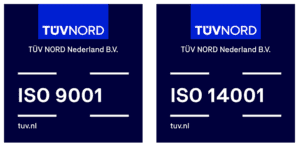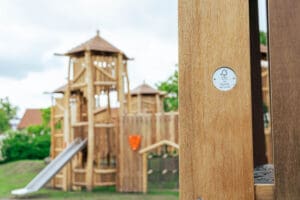Safety
Children must be able to play safely. Pushing boundaries and taking risks are a natural part of play. Falling is part of the experience – and so are the occasional bumps and bruises. That’s why play areas must meet strict safety requirements for equipment and impact-absorbing surfaces. There should also be no obstacles positioned directly next to any play equipment. Play structures fall under the Dutch Commodities Act Decree on Attractions and Playground Equipment (WAS), which regulates the safety of such equipment.
The law (WAS – Commodities Act Decree on Attractions and Playground Equipment) states that if equipment complies with the NEN 1176 standard, it is presumed to be safe. As a member of the NEN-1176 / NEN-1177 standards committee for playground equipment and impact-absorbing surfaces, we are committed to the development and production of safe play equipment. All our equipment complies with NEN 1176 standards and is supplied with the corresponding inspection certificate. Fall surfaces must comply with the NEN 1177 standard.

Certification
As a manufacturer of play equipment, we are also ISO 9001, ISO 14001 and KOMO certified, and we produce with environmental awareness to minimise waste streams. In designing our equipment, we consider recycling and the reuse of materials, aiming for such a sustainable level of quality that we guarantee a minimum lifespan of 15 years. For a large part of our products, we even offer a lifetime warranty*!
Most of our products are manufactured in-house at our production site in Nieuwendijk, centrally located in the Netherlands. We produce sustainable, high-quality products and services while striving to minimise residual waste.
In the early 1980s, we were the first company in the world to manufacture play equipment from recycled plastic. Additionally, our wooden play structures are FSC® certified. Through our subsidiary, VISSERgroen, we are also certified by NL Greenlabel.

FSC® certified wood
In recent years, a large number of sustainability certifications and quality marks have entered the market. This can make it challenging for customers and consumers to determine which certifications are relevant when choosing products — and why. Which is best, and how do we choose between established and newer schemes? For an overview of the different labels applicable to wood, you can consult the certification guide provided by Milieu Centraal.
What we consider most important is that our products are made from sustainable materials with the lowest possible impact on people and the environment. That’s why we consciously choose to use FSC® certified wood in the production of our wooden products.
This means the following in practice:
What exactly does FSC certification entail? It’s a question we are often asked. All the wood we use is FSC-certified. This means that the forests from which our wood is sourced are managed in such a way that they remain intact — with enough space for wildlife to retreat and thrive. FSC-certified concessions (agreements granting the right to harvest resources in a specific area) are managed extensively and responsibly.
Forest protection
By specifying and using certified wood, a forest area is protected. There is a sufficient supply of certified wood available at competitive prices. The greater the demand we create together, the more forest is sustainably managed. FSC-managed forests exert low environmental pressure. Wood—including hardwood—has a relatively low CO² footprint compared to other materials. A study by Beco (2013) showed that hardwood is an environmentally friendly material for construction.
Wooden products also contribute to the reduction of greenhouse gases and help combat global warming. They store enough carbon to more than offset the emissions produced by transport to our region.
So, what impact are you making when designing a playground? Here’s an example: The Alpine Playground is located next to the restaurant and large outdoor terrace of SnowWorld Zoetermeer. This themed playground, featuring large timber-framed houses and other play elements, was completed in 2019. Azobé wood was chosen for the construction due to its strength, allowing for large structures to be built. In addition, louro preto, louro itauba, and robinia were used — types of wood that do not splinter, making them ideal for playground use.
For the climbing frames, play elements, and accompanying seating furniture, around 6.5 m³ of FSC-certified azobé, louro itauba, and louro preto wood was used. With this, BOERplay helps protect approximately 13,000 m² of tropical forest for 30 years.



